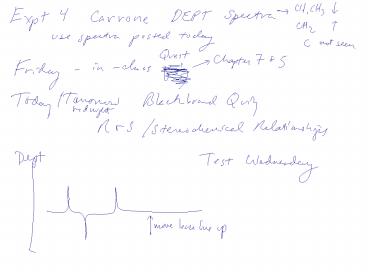Diastereomers - PowerPoint PPT Presentation
1 / 18
Title:
Diastereomers
Description:
With chiral compounds, the plane of polarized light is rotated. ... chemical properties except for their reaction with chiral non-racemic reagents. ... Chiral Drugs ... – PowerPoint PPT presentation
Number of Views:1206
Avg rating:3.0/5.0
Title: Diastereomers
1
(No Transcript)
2
Diastereomers
Diastereomers
3
Summary of Types of Isomers
4
Flow Chart for Determining Relationship
5
Disubstituted Cycloalkanes
- Consider 1,3-dibromocyclopentane. Since it has
two stereogenic centers, it has a maximum of four
stereoisomers.
- Recall that a disubstituted cycloalkane can have
two substituents on the same side of the ring
(cis isomer, A) or on opposite sides of the ring
(trans isomer, B). These compounds are
stereoisomers but not mirror images.
6
Cis/meso
- To draw the other two stereoisomers if they
exist, draw mirror images of each compound and
determine whether the compound and its mirror
image are superimposable.
- The cis isomer is superimposable on its mirror
image, making the images identical. Thus, A is an
achiral meso compound.
7
trans
- The trans isomer is not superimposable on its
mirror image, labeled C, making B and C different
compounds. B and C are enantiomers.
- Because one stereoisomer of 1,3-dibromocyclopentan
e is superimposable on its mirror image, there
are only three stereoisomers, not four.
8
Disubstituted Cyclohexanes
9
(No Transcript)
10
Polarimeter
- With chiral compounds, the plane of polarized
light is rotated. The angle of rotation ? is
measured in degrees (0), and is called the
observed rotation. A compound that rotates
polarized light is said to be optically active.
11
() vs (-) rotation
- If the rotation is clockwise (to the right of the
noon position), the compound is called
dextrorotatory. The rotation is labeled d or (). - If the rotation is counterclockwise, (to the left
of noon), the compound is called levorotatory.
The rotation is labeled l or (-). - Two enantiomers rotate plane-polarized light to
an equal extent but in opposite directions. Thus,
if enantiomer A rotates polarized light 50, the
same concentration of enantiomer B rotates it
50. - No relationship exists between R and S prefixes
and the () and (-) designations that indicate
optical rotation.
12
Specific Rotation
- Specific rotation is a standardized physical
constant for the amount that a chiral compound
rotates plane-polarized light. Specific rotation
is denoted by the symbol ? and defined using a
specific sample tube length (l, in dm),
concentration (c in g/mL), temperature (25 0C)
and wavelength (589 nm).
13
Physical Properties of Stereoisomers
- An equal amount of two enantiomers is called a
racemic mixture or a racemate. A racemic mixture
is optically inactive. Because two enantiomers
rotate plane-polarized light to an equal extent
but in opposite directions, the rotations cancel,
and no rotation is observed.
14
Enantiomeric excess (optical purity)
- Enantiomeric excess (optical purity) is a
measurement of how much one enantiomer is present
in excess of the racemic mixture. It is denoted
by the symbol ee.
ee of one enantiomer - of the other
enantiomer.
- Consider the following exampleIf a mixture
contains 75 of one enantiomer and 25 of the
other, the enantiomeric excess is 75 - 25
50. Thus, there is a 50 excess of one
enantiomer over the racemic mixture. - The enantiomeric excess can also be calculated if
the specific rotation ? of a mixture and the
specific rotation ? of a pure enantiomer are
known.
ee (? mixture/? pure enantiomer) x 100.
15
Separation of Stereoisomers
- Since enantiomers have identical physical
properties, they cannot be separated by common
physical techniques like distillation. - Diastereomers and constitutional isomers have
different physical properties, and therefore can
be separated by common physical techniques.
16
Where Enantiomers Differ
17
Biological Properties of Enantiomers
18
Chiral Drugs
- Two enantiomers have exactly the same chemical
properties except for their reaction with chiral
non-racemic reagents. - Many drugs are chiral and often must react with a
chiral receptor or chiral enzyme to be effective.
One enantiomer of a drug may effectively treat a
disease whereas its mirror image may be
ineffective or toxic.































